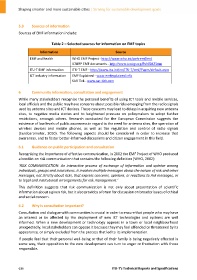Page 626 - Shaping smarter and more sustainable cities - Striving for sustainable development goals
P. 626
5.3 Sources of information
Sources of EMF information include:
Table 2 – Selected sources for information on EMF topics
Information Source
EMF and health WHO EMF Project ‐ http://www.who.int/peh‐emf/en/
ICNIRP EMF documents ‐ http://www.icnirp.org/PubEMF.htm
ITU‐T EMF information ITU‐T EMF ‐ http://www.itu.int/en/ITU‐T/emf/Pages/default.aspx
ICT industry information EMF Explained ‐ www.emfexplained.info
SAR Tick ‐ www.sar‐tick.com
6 Community information, consultation and engagement
While many stakeholders recognize the personal benefits of using ICT tools and mobile services,
local officials and the public may have concerns about possible risks emerging from the radio signals
used by antenna sites and ICT devices. These concerns may lead to delays in acquiring new antenna
sites, to negative media stories and to heightened pressure on policymakers to adopt further
restrictions, amongst others. Research conducted for the European Commission suggests the
existence of low levels of public awareness in regard to the need for antenna sites, the operation of
wireless devices and mobile phones, as well as the regulation and control of radio signals
(Eurobarometer, 2010). The following aspects should be considered in order to increase that
awareness, and to foster better‐informed discussions and citizen engagement in this field.
6.1 Guidance on public participation and consultation
Recognizing the importance of effective communication, in 2002 the EMF Project of WHO produced
a booklet on risk communication that contains the following definition (WHO, 2002):
‘RISK COMMUNICATION: An interactive process of exchange of information and opinion among
individuals, groups and institutions. It involves multiple messages about the nature of risk and other
messages, not strictly about risks, that express concerns, opinions, or reactions to risk messages, or
to legal and institutional arrangements for risk management.’
This definition suggests that risk communication is not only about presentation of scientific
information about a given risk, but it also provides a forum for discussion on broader issues of ethical
and social concern.
6.2 Why is consultation important?
Consultation and dialogue with communities is crucial in order to ensure that people who may have
an interest or be affected by the deployment of new ICT technologies and systems are well
informed. When a new development or technology appears in a town or local neighbourhood
unexpectedly, local stakeholders can oppose it because they may feel offended or threatened by its
appearance, or simply excluded from the process that led to its implementation.
If people feel that their personal well‐being or that of their family is being negatively affected in
some way, their opposition to the new development can turn to anger or frustration with those
responsible.
616 ITU‐T's Technical Reports and Specifications

